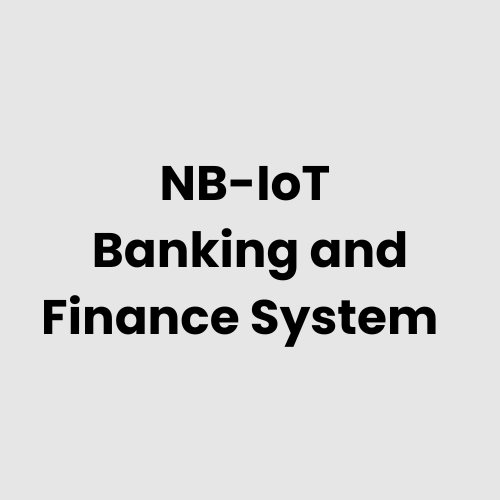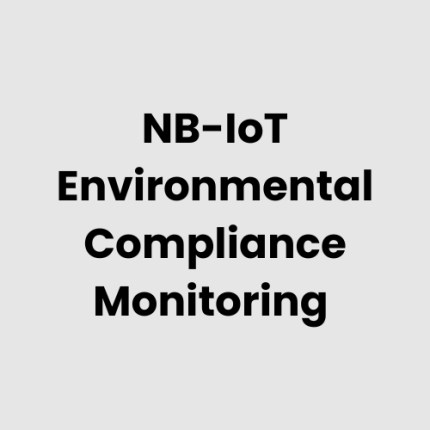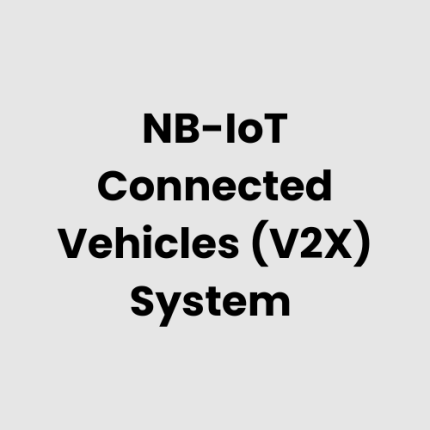Description
Technical Architecture of the NB-IoT Enabled Banking and Finance IoT System
The NB-IoT Enabled Banking and Finance IoT System leverages the NB-IoT (Narrowband IoT) network to provide secure, scalable, and efficient monitoring solutions for financial institutions. The architecture integrates several components that work cohesively to ensure real-time data collection, transaction monitoring, and security across financial networks.
- IoT Devices: Devices such as smart sensors and POS (point-of-sale) systems, security cameras, and biometric scanners are deployed in branches, ATMs, and mobile units.
- Gateway & Edge Computing Devices: These devices process local data and facilitate secure communication between IoT devices and cloud-based platforms via NB-IoT.
- Cloud Server/Local Server: Data collected from the devices is securely transmitted to cloud storage or a local server for processing and analytics.
- Analytics & Monitoring: A centralized platform analyzes transaction data, security metrics, and other key financial indicators for risk management and fraud detection.
Hardware of the NB-IoT Enabled Banking and Finance IoT System
- NB-IoT Sensors: For monitoring environmental conditions (e.g., temperature, humidity) within financial institutions.
- Smart POS Terminals: Connected devices for payment processing and transaction monitoring.
- Biometric Scanners: Fingerprint and facial recognition systems for secure user authentication.
- Cameras and Video Surveillance: High-definition security cameras integrated with IoT capabilities to monitor customer activities and prevent fraud.
- Smart Locking Systems: Automated, IoT-enabled locks for vaults, doors, and safes in banks and other financial facilities.
- Edge Computing Units: These devices manage local data storage and analysis, providing quick insights and decision-making before data is sent to the cloud.
- Communication Gateways: Routers and modems that manage the NB-IoT network traffic between the devices and the centralized platform.
Physical Placement Considerations of the Hardware in the NB-IoT Enabled Banking and Finance IoT System
- Branch Locations: Sensors and cameras should be strategically placed in customer areas, teller stations, and ATMs to capture real-time data, monitor transactions, and detect any unusual behavior.
- ATMs: Install environmental sensors to detect physical anomalies, such as temperature changes or attempts at tampering.
- Server Rooms: Edge computing devices and local servers must be placed in secure, climate-controlled rooms to ensure optimal performance and data integrity.
- Entrance Points and Vaults: Smart locks and biometric scanners should be installed at all entry points, including vault doors, to control access and enhance physical security.
- Mobile Units: For mobile banking services, lightweight IoT sensors can be installed in vehicles or kiosks to monitor operational conditions and ensure secure transactions on the move.
Hardware Architecture of the NB-IoT Enabled Banking and Finance IoT System
The NB-IoT Enabled Banking and Finance IoT System hardware architecture consists of three primary layers:
- Device Layer: Includes all the IoT devices such as sensors, POS terminals, biometric scanners, and surveillance equipment. These devices collect data and communicate it to the gateway layer.
- Gateway Layer: This layer involves the use of communication gateways, routers, and edge computing devices that process local data and provide secure communication to central systems.
- Data Management Layer: This is where the data is processed either on a local server or in the cloud. It handles storage, analysis, and reporting, ensuring real-time transaction monitoring, fraud detection, and risk management.
Deployment Considerations for the NB-IoT Enabled Banking and Finance IoT System
- Scalability: The system should be designed to scale from small branches to large banking networks, supporting thousands of devices and locations across the globe.
- Security: Due to the sensitivity of banking data, security should be a priority during deployment, with end-to-end encryption for all communication between devices, gateways, and cloud servers.
- Compatibility: Ensure compatibility with legacy banking systems, allowing the integration of existing infrastructure such as older POS systems or ATMs.
- Network Coverage: The NB-IoT network must provide reliable, low-latency coverage, especially in remote or rural locations where other IoT networks may be lacking.
- Compliance: The system must be designed to meet local and international regulations regarding financial data, including PCI-DSS compliance and data privacy standards.
List of Relevant Industry Standards and Regulations
- PCI-DSS (Payment Card Industry Data Security Standard)
- GDPR (General Data Protection Regulation)
- ISO/IEC 27001 (Information Security Management System)
- FATF (Financial Action Task Force) Regulations
- SOX (Sarbanes-Oxley Act)
- NIST 800-53 (National Institute of Standards and Technology Security Controls)
- Basel III (Banking Supervision Regulations)
- MiFID II (Markets in Financial Instruments Directive)
- EMV (Europay, MasterCard, and Visa Security Standards)
- Dodd-Frank Act (U.S. Financial Regulation)
Local Server Version: Running with a Local Server
The NB-IoT Enabled Banking and Finance IoT System can be implemented on a local server for those financial institutions that require on-premise data management. The local server version offers the following benefits:
- Data Security: All sensitive financial data is stored within the organization’s premises, allowing for greater control and security.
- Reduced Latency: Real-time analytics and monitoring can be performed without the reliance on cloud infrastructure.
- Customization: Financial institutions can tailor the system’s software to fit their specific requirements and integrate it with internal platforms.
Cloud Integration and Data Management
Cloud integration plays a crucial role in the NB-IoT Enabled Banking and Finance IoT System, providing the following features:
- Centralized Data Management: All data from IoT devices across different branches or locations is sent to the cloud for centralized processing and storage.
- Advanced Analytics: Cloud platforms enable advanced analytics such as fraud detection, predictive maintenance, and operational optimization.
- Real-Time Monitoring: Financial institutions can monitor their entire network of IoT-enabled devices in real-time, receiving alerts about security breaches, anomalies, or system failures.
- Scalability: The cloud provides the scalability needed for growing banking operations, enabling institutions to expand the system without worrying about infrastructure limitations.
GAO Case Studies: NB-IoT Enabled Banking and Finance IoT System
USA Case Studies
- New York City, NY
- Implementation: Real-time transaction monitoring and fraud detection.
- Impact: Enhanced mobile transaction security, reduced operational costs, and improved customer experience.
- Los Angeles, CA
- Implementation: Optimized ATM security with predictive maintenance.
- Impact: Increased uptime and operational efficiency.
- Chicago, IL
- Implementation: Vault security with IoT sensors.
- Impact: Streamlined operations, enhanced remote monitoring, and reduced unauthorized access risks.
- San Francisco, CA
- Implementation: Biometric sensors for identity verification.
- Impact: Faster authentication and reduced fraud risks.
- Miami, FL
- Implementation: Real-time fraud detection for online banking.
- Impact: Protected customer accounts and boosted digital trust.
- Dallas, TX
- Implementation: Predictive maintenance for ATMs and branch infrastructure.
- Impact: Reduced equipment downtime and improved operational continuity.
- Houston, TX
- Implementation: Real-time surveillance of transaction activity.
- Impact: Enhanced security with proactive fraud alerts.
- Boston, MA
- Implementation: Secure payment processing across ATMs and POS terminals.
- Impact: Encrypted communications and compliance with security standards.
- Washington, D.C.
- Implementation: Data encryption for securing financial data.
- Impact: Compliance with federal regulations and enhanced data integrity.
- Seattle, WA
- Implementation: ATM network reliability improvement.
- Impact: Real-time data for better operational efficiency.
- Atlanta, GA
- Implementation: Online fraud detection with IoT sensors.
- Impact: Minimized fraud incidents and ensured transaction safety.
- Denver, CO
- Implementation: Automated cash management.
- Impact: Reduced errors and enhanced efficiency.
- Philadelphia, PA
- Implementation: Vault security optimization.
- Impact: Seamless integration with security systems for real-time updates.
- Las Vegas, NV
- Implementation: ATM monitoring and maintenance automation.
- Impact: Reduced overhead and improved ATM availability.
- Phoenix, AZ
- Implementation: IoT-enabled loan management system.
- Impact: Enhanced document security and regulatory compliance.
Canada Case Studies
- Toronto, ON
- Implementation: Branch security and ATM monitoring.
- Impact: Improved response times and enhanced customer experience.
- Vancouver, BC
- Implementation: Secure mobile banking with IoT solutions.
- Impact: Continuous data security and improved operational efficiency.
Navigation Menu for NB-IoT:
Navigation Menu for IoT
- LORAWAN
- Wi-Fi HaLow
- Z-WAVE
- BLE & RFID
- NB-IOT
- CELLULAR IOT
- GPS IOT
- IOT SENSORS
- EDGE COMPUTING
- IOT SYSTEMS
Our products are in stock and can be shipped anywhere in the continental U.S. or Canada from our local warehouse. For any further information, please fill out this form or email us.
We are actively looking for partners who are like us located in the U.S. and Canada. For more information on partnering with GAO, please visit Partner with GAO Tek Inc. It lists various ways to partner with GAO, such as OEM Partnerships, Technology Integration, Distribution and Reselling Opportunities, Presenting at the Leading Event Tek Summit, Joint R&D Projects, Training and Consulting Services, Industry-Specific Collaborations, Research and Academic Partnerships.



